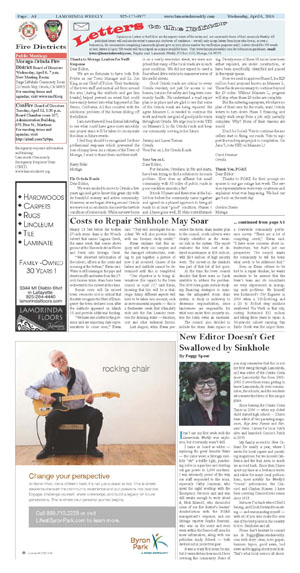|
|
Published April 6th, 2016
|
Costs to Repair Sinkhole May Soar
|
|
| By Sophie Braccini |
|
|
The massive sinkhole at the crossing of Center Street and Rheem Blvd. is going to be a very costly burden for the Town of Moraga.
 Town Public Works Director Edric Kwan estimated last week that the sinkhole, which punctured gas lines, will cost $3.5 million, and that's just a conservative preliminary analysis. The damage is extensive and includes fixing Laguna Creek's 96-foot-deep seeded culvert, an area that had been identified as "high risk" in the town's storm drain master plan.
Town Public Works Director Edric Kwan estimated last week that the sinkhole, which punctured gas lines, will cost $3.5 million, and that's just a conservative preliminary analysis. The damage is extensive and includes fixing Laguna Creek's 96-foot-deep seeded culvert, an area that had been identified as "high risk" in the town's storm drain master plan.
 The cause of the collapse is still under investigation and options for repair will be brought forward at the April 27 town council meeting. The intersection is likely to be disrupted for many more months.
The cause of the collapse is still under investigation and options for repair will be brought forward at the April 27 town council meeting. The intersection is likely to be disrupted for many more months.
 "We are still investigating the reason why the sinkhole formed," Kwan said. First workers had to stabilize the hole for safe access, and dig deep into the debris to uncover all the layers. Nearly 23 feet below the broken 27-inch storm drain is the 96-inch culvert that carries Laguna Creek, the same creek that comes above ground at the Hacienda de las Flores and feeds into Moraga Creek.
"We are still investigating the reason why the sinkhole formed," Kwan said. First workers had to stabilize the hole for safe access, and dig deep into the debris to uncover all the layers. Nearly 23 feet below the broken 27-inch storm drain is the 96-inch culvert that carries Laguna Creek, the same creek that comes above ground at the Hacienda de las Flores and feeds into Moraga Creek.
 "We observed deformation of the culvert, offsets at the joints and scouring at the bottom," Kwan said. Water is still running in the pipe and street runoffs and water from the 27-inch broken storm drain have been redirected to the culvert at this time.
"We observed deformation of the culvert, offsets at the joints and scouring at the bottom," Kwan said. Water is still running in the pipe and street runoffs and water from the 27-inch broken storm drain have been redirected to the culvert at this time.
 Repair costs will far exceed town resources so it is critical that the state recognize the State of Emergency the town declared soon after the sinkhole appeared on March 13, and provide additional funding.
Repair costs will far exceed town resources so it is critical that the state recognize the State of Emergency the town declared soon after the sinkhole appeared on March 13, and provide additional funding.
 "We have sent a letter to the governor and are expecting state representatives to come soon," Kwan said. "They will investigate the incident. We will also provide them with our forensic study results."
"We have sent a letter to the governor and are expecting state representatives to come soon," Kwan said. "They will investigate the incident. We will also provide them with our forensic study results."
 Kwan explains that this inquiry will study soil samples and the damaged infrastructure, seeking to put together a picture of how it all occurred. Causes of the failure and sinkhole cannot be determined until this is completed.
Kwan explains that this inquiry will study soil samples and the damaged infrastructure, seeking to put together a picture of how it all occurred. Causes of the failure and sinkhole cannot be determined until this is completed.
 "Our objective is to bring alternatives (for repair) to the town council on April 27," said Kwan, knowing that this will be a challenge. Many different aspects will have to be taken into account, such as environmental impacts - this is a freshwater creek that ultimately ends into the San Leandro reservoir for drinking water - timeline, cost and other technical factors.
"Our objective is to bring alternatives (for repair) to the town council on April 27," said Kwan, knowing that this will be a challenge. Many different aspects will have to be taken into account, such as environmental impacts - this is a freshwater creek that ultimately ends into the San Leandro reservoir for drinking water - timeline, cost and other technical factors.
 Last August, when Kwan presented the storm drain master plan to the council, creek culverts were clearly identified as the weakest link in the system. The report evaluated the total cost of delayed maintenance at $26 million, with $8.9 million of high priority work. The culvert in the sinkhole was part of that list of hot spots.
Last August, when Kwan presented the storm drain master plan to the council, creek culverts were clearly identified as the weakest link in the system. The report evaluated the total cost of delayed maintenance at $26 million, with $8.9 million of high priority work. The culvert in the sinkhole was part of that list of hot spots.
 At the time the town council decided that there were no funds available to address the problem. The 2016 town goals include studying financing strategies to maintain the antiquated storm drain system. A study is underway to determine responsibilities, since landowners are responsible for what runs under their property unless the town owns an easement.
At the time the town council decided that there were no funds available to address the problem. The 2016 town goals include studying financing strategies to maintain the antiquated storm drain system. A study is underway to determine responsibilities, since landowners are responsible for what runs under their property unless the town owns an easement.
 The council also decided to include the storm drain repairs in a townwide community preference survey. "There are a lot of competing needs," Kwan said. "I have more concerns about infrastructure, but that's just one perspective. The council wants the community to tell the town what needs to be addressed first."
The council also decided to include the storm drain repairs in a townwide community preference survey. "There are a lot of competing needs," Kwan said. "I have more concerns about infrastructure, but that's just one perspective. The council wants the community to tell the town what needs to be addressed first."
 Even as Kwan refuses to be tied to a repair deadine, he wants residents to be assured that the town's team and its consultants are very experienced in managing such problems. He himself was Richmond's City Engineer in 2010 when a 120-foot-long and a 20- to 30-foot deep sinkhole swallowed Via Verdi in that city, costing Richmond $12 million and taking three years to repair. A 30-year-old culvert carrying San Pablo Creek was the culprit there.
Even as Kwan refuses to be tied to a repair deadine, he wants residents to be assured that the town's team and its consultants are very experienced in managing such problems. He himself was Richmond's City Engineer in 2010 when a 120-foot-long and a 20- to 30-foot deep sinkhole swallowed Via Verdi in that city, costing Richmond $12 million and taking three years to repair. A 30-year-old culvert carrying San Pablo Creek was the culprit there.


|
|
|
|
|
|
|
|
|
| |
|
|
|
|



